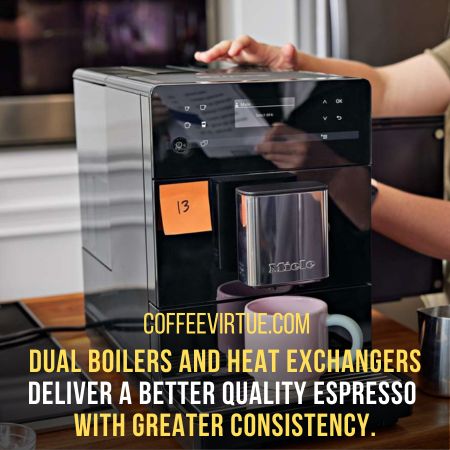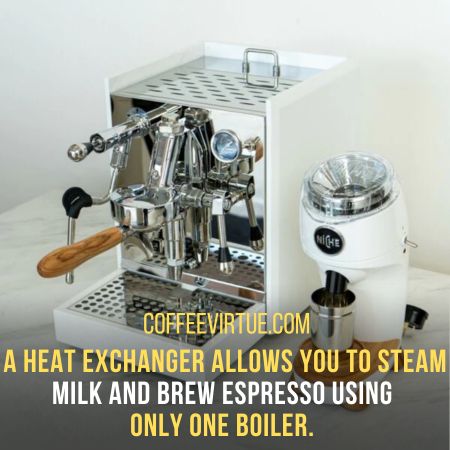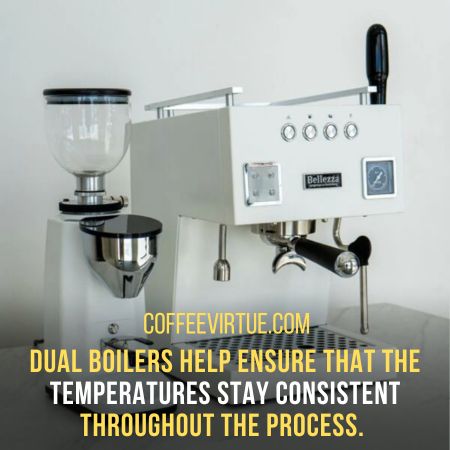Heat exchanger vs. dual boiler in expresso machines has a long debate. Both works to generate a delicious cup of coffee.
What Will I learn
In this article, you’ll understand the difference between heat exchanger vs. dual boiler.
Heat Exchanger Vs. Dual Boiler
When selecting an espresso machine, the important decision is deciding between a heat exchanger and a dual boiler.
A heat exchanger allows you to steam milk and brew espresso using only one boiler.
In contrast, a dual boiler has two separate boilers for steaming milk and brewing espresso.
The biggest benefit of a heat exchanger is that it takes up less space, making it ideal for small cafes or home use.

It also requires fewer resources to operate than a dual boiler. The major drawback is that hot water from the steam boiler is used for extraction.
There can be some temperature variations during the process which will affect flavor.
On the other hand, dual-boiler espresso machines offer more stability. They have two reliable sources of heat.
This helps ensure that the temperatures stay consistent throughout the entire process.
It enables greater control over flavor and extraction. In contrast, this type of machine is larger than a heat exchanger.
It requires more resources to operate. It delivers an overall better quality espresso with greater consistency.
Heat Exchanger
Heat exchangers help regulate the temperature of the grinder. It allows it to operate efficiently.
This is done by exchanging heat between two fluids, typically a coolant and hot air. Heat exchangers use a series of metal plates.
They have channels running through them. They allow the two fluids to pass over each other and transfer energy as they do so.
The fluid entering the heat exchanger is heated up by the hotter fluid flowing around it. It transfers its thermal energy in the process.
This helps keep the grinder operating at an optimal temperature level. It also prevents it from overheating or short-circuiting due to excessive internal temperatures.
Heat exchangers can be used for cooling many industrial machines. It includes large machinery such as turbines and compressors.
They help keep all the components safe and working at their best.
Advantages Of Using A Heat Exchanger In Grinder:
Heat exchangers are an effective way to improve the longevity of grinders.
A heat exchanger is a device that transfers energy from one medium to another, such as air or liquid.
By using a heat exchanger within a grinder, the transfer of heat can be controlled more precisely. It results in improved performance and reduced wear on parts.
Here are some advantages of incorporating a heat exchanger into your grinder:
1. Improved Efficiency:
Heat exchangers allow for more efficient use of energy. It does this by controlling the heat entering and exiting the grinding chamber.
This results in less wasted energy compared to conventional methods. It makes it possible for grinders to run longer without being shut down to cool off.
2. Reduced Wear And Tear:
Heat exchangers can reduce the amount of wear and tear on grinder parts. It is done by controlling the temperature of the grinding chamber.
They protect components from damage by ensuring temperatures don’t exceed a certain level.
This not only keeps grinders running more smoothly but helps extend their lifespan.
3. Reduce Noise Levels:
Heat exchangers help reduce the noise levels produced by metal-on-metal contact within grinders. They act like insulation between components.
This allows for quieter operation. It makes it easier to work in environments where noise levels are already high.
4. Increased Safety:
Heat exchangers help to control the temperature of grinders. They help prevent overheating and other issues that may otherwise cause safety hazards.
Keeping temperatures at a safe level, they help ensure that grinders are running safely.
5. Improved Quality:
Heat exchangers help to improve the quality of grinding results. They control the temperature throughout the process.
This helps to ensure consistent results over time without any fluctuations in quality. It allows for higher-quality output with fewer defects or imperfections.
Incorporating a heat exchanger into the grinder boost performance and prolong its lifespan.
Not only does it reduce wear and tear on components, but it also helps increase efficiency,
Disadvantages Of Using Heat Exchanger In Grinder Works:
Consider the disadvantages of a heat exchanger before buying one. These can make a huge difference in your decision.
Here are a few of the disadvantages of using a heat exchanger:
1. Risk Of Thermal Stress:
Using a heat exchanger can cause thermal stress to components within the system. This can result in premature failure.

It can be costly and dangerous for personnel working on the machine. It can also lead to inefficient grinding operations due to poor heat transfer.
2. Maintenance Costs:
Heat exchangers need regular maintenance and servicing due to their intricate design. The cost of such maintenance over time may be significant.
It can be costly compared to other types of grinders. Those with internal combustion engines or turbine-driven mechanisms need less maintenance.
3. Inefficient Heat Transfer:
Heat exchangers are limited ability to transfer heat from one component to another. as they cannot regulate the system’s temperature properly.
This can lead to inefficient grinding operations. It can cause components within the system to overheat or become damaged. It can be due to excessive temperatures.
4. Costly Installation:
Installing a heat exchanger in a grinder works more expensive than other grinders. It is due to its high-power requirement and complex design.
The cost of installation and set-up can be very costly. When considering the additional costs associated with maintenance and servicing over time.
5. Complex Design:
Heat exchangers have complex design requirements. They require special tools and expertise to install. This adds to the cost of installation and maintenance.
It makes it difficult for less experienced personnel to work on them.
Heat exchangers can be a disadvantageous choice for grinder works. Many grinders choose to use them due to their superior level of performance.
Considering the disadvantages of using a heat exchanger before investing in one is important.
Dual Boiler
A dual boiler in a grinder is a special feature that many coffee lovers appreciate. This type of grinder has two separate heating elements.
It means it can grind coffee beans at two different temperatures simultaneously.
The dual boilers ensure that the optimal temperature for grinding is consistently maintained. It results in more even extraction and better-tasting coffee.
The dual boilers provide greater control over brewing time and water flow rate.
It helps further to customize each cup of coffee to your personal preference.
With this advanced technology, you can confidently craft the perfect cup every time.
Advantages Of Using Dual Boiler In Grinder:
A dual boiler in a grinder is an excellent choice for coffee lovers who want the best possible cup of coffee.
It can provide superior performance and flavor extraction. Here are some key advantages of having a dual boiler system:
1. Improved Temperature Control:
A dual-boiler grinder allows for better temperature control than other single-boiler systems.
It is because it has separate boilers for both brewing and steaming. This means that you can adjust the temperature settings for each process.
It ensures more consistent results.
2. Faster Heating Times:
Since two boilers are used instead of one, your water will heat up faster with a dual boiler system. This is beneficial for espresso lovers.
This can lead to faster and more efficient brewing times.
3. Better Flavor Extraction:
The dual boiler grinder helps to improve temperature control. It helps extract all the desirable flavors from your coffee beans.
This means you’ll get a better-tasting cup of coffee with every brew.
4. More Consistency:
As mentioned earlier, having two boilers allows for better temperature control. It allows consistent results across each cup of coffee brewed or steamed in this system.
Dual boiler grinders are great for those who want an improved cup of coffee.
Every time they brew or steam it with their machine.
With better temperature control and flavor extraction, a dual boiler grinder can be the perfect choice for any coffee lover.
Disadvantages Of Using Dual Boiler In Grinder Works:
There are several disadvantages to using a dual boiler in the grinder. These drawbacks make them less reliable.
Here are a few o disadvantages of dual boilers:
1. Expensive:
Using dual boilers in grinder works can be quite expensive. It is due to the extra equipment and maintenance costs associated with it.
Besides, it has a higher initial investment cost. It may not be viable for smaller companies or businesses.
2. Increased Complexity:
A dual boiler system is more complex than a single boiler system. It requires more technical knowledge and skills to install and operate properly.
This can lead to longer setup times. Also, it can increase maintenance costs if something goes wrong.
3. Reduced Efficiency:
Due to its complexity, a dual boiler system is less efficient than a single boiler system. It requires more energy to run.
This can lead to higher electricity bills and increased waste.
4. Limited Capacity:
Dual boiler systems are limited in capacity when compared to single boiler systems.
They use two separate boilers instead of one, which limits the amount of water that can be heated at any given time.
As a result, it may not be suitable for larger operations or companies with high demand for hot water.
5. Space Requirements:
Dual boilers require more space than single boilers due to their complexity and size.
If you don’t have space in your establishment, then using a dual boiler system might not be the best option.

Using a dual boiler system in grinder works can provide several drawbacks. You must consider before making the decision.
It is important to weigh all the pros and cons to determine which type of boiler system will best suit your needs.
Conclusion:
The heat exchanger and dual boiler espresso machines both have their advantages. They can be set according to your type of coffee grinder.
The heat exchanger offers more convenience and cost savings. It only has one boiler that heats all your water within the espresso machine.
On the other hand, the dual boiler model offers control for steaming and brewing. It provides optimal temperature stability.
Both types can produce excellent coffee. It depends on your lifestyle and budget. One may be better suited to you than the other.
It’s up to you to decide what type best suits your needs so that you can enjoy a wonderful cup of espresso every time.